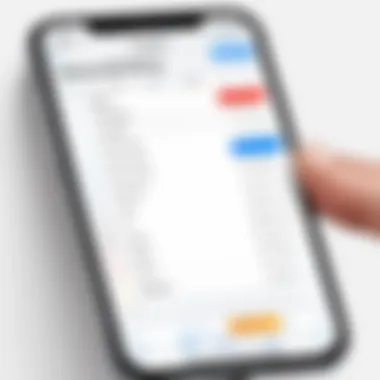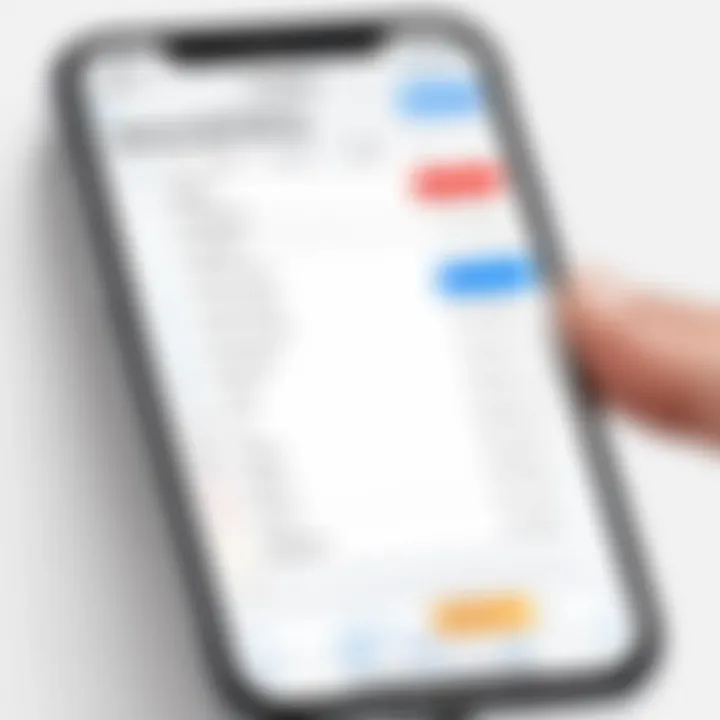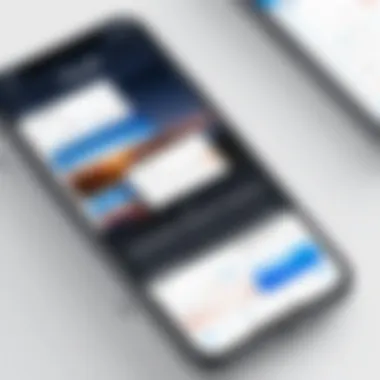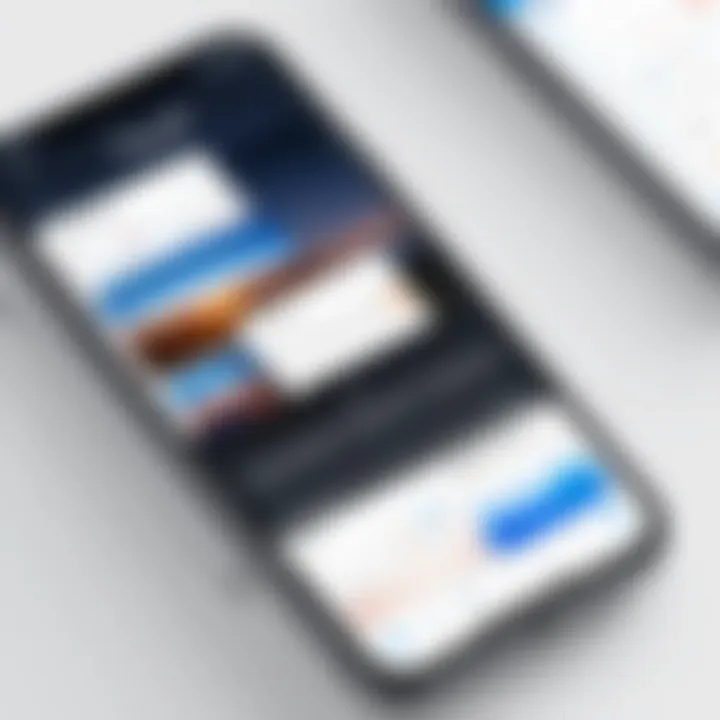Mastering Calendar Integration on Your iPhone
Intro
Managing multiple calendars can be daunting, especially for those juggling personal and professional commitments. The iPhone calendar app provides an array of options, allowing users to combine different calendars effortlessly. Understanding how to navigate these features can greatly enhance organization and productivity. In this guide, we will explore the methods and considerations involved in merging calendars on an iPhone. This includes technical steps, tips for effective synchronization, and practical insights to help you maintain a clear overview of your activities.
Overview of the Technology
The iPhone calendar system is designed for flexibility and integration. iPhone users can connect various calendars from services like Google Calendar, Outlook, and Apple Calendar itself. This seamless synchronization allows users to view all relevant events in a single interface, which is critical for effective time management.
Key specifications
- Synchronization: Calendars sync in real time, reducing the chances of double booking.
- Notification features: Users can set reminders to ensure important events are not overlooked.
- Cross-platform accessibility: Events can be viewed and managed across different devices.
Unique selling points
One of the significant advantages of the iPhone calendar is its user-friendly interface and easy navigation. The calendar’s ability to color-code different calendars makes it easier to distinguish between personal and work commitments at a glance. Additionally, the integration with Siri enhances the experience, allowing users to add events via voice commands effortlessly.
"A well-organized calendar can significantly boost productivity and reduce stress."
Practical Considerations for Combining Calendars
When combining multiple calendars on an iPhone, several factors should be taken into account. Here are some practical tips to ensure a smooth merging process:
- Check compatibility: Ensure the calendars you wish to combine can sync with iPhone’s native calendar.
- Color-coding: Assign different colors to each calendar for easy identification.
- Set up shared calendars: If collaboration is necessary, set up shared calendars with colleagues or family members for better synchronization.
By systematically addressing these considerations, users can maintain organization and avoid misunderstandings regarding schedule conflicts.
The End
Merging calendars on the iPhone is a critical skill for individuals managing diverse schedules. This guide assists users in understanding the technical specifications and practical implications of combining multiple calendars. By focusing on usability and effective organization, your iPhone can become a powerful tool in managing time and commitments effectively.
Prelude
In a world where personal and professional commitments continuously intertwine, the efficacy of managing calendars becomes paramount. The introduction of multiple calendars on an iPhone allows individuals to organize their schedules more effectively. This article centers on how to combine these calendars seamlessly. By understanding the nuances and methods involved, users can streamline their time management.
The importance of this topic lies in its capacity to eliminate confusion and enhance productivity. Calendar syncing offers clarity for planning events and appointments. Whether navigating personal engagements or professional obligations, the ability to view all commitments in one consolidated view is invaluable.
Moreover, with many people relying on various digital calendars such as iCloud Calendar, Google Calendar, and other third-party applications, integrating them creates a centralized hub for time management. It affords users the flexibility to respond to last-minute changes and update their schedules on the go.
By delving into the steps required to combine these calendars, this article aims to equip readers with the tools necessary for efficient calendar management on their iPhones. Whether you're tech-savvy or just beginning to explore digital organization tools, this guide is structured to meet diverse needs and elevate your calendar experience.
Understanding iPhone Calendars
Understanding the various calendars available on the iPhone is essential for anyone looking to effectively manage their schedules. This comprehension lays the groundwork for effectively combining calendars and ensuring seamless synchronization across different platforms. With options like iCloud Calendar and Google Calendar, users can select tools that fit their needs, thereby enhancing productivity.
Types of Calendars
iCloud Calendar
The iCloud Calendar is Apple's proprietary calendar solution, tightly integrated into the Apple ecosystem. One of its most notable features is the ability to automatically sync across all Apple devices—iPhone, iPad, Mac, etc. This means that events added on one device are reflected on all others almost instantly.
The iCloud Calendar is popular due to its simplicity and seamless user experience. Users can share calendars with family or coworkers, allowing for collaborative event planning. However, a disadvantage may be its limited functionality compared to other service providers. While it works exceptionally well for Apple users, those who frequently interact with non-Apple users might find it less versatile.
Google Calendar
Google Calendar is a widely used tool known for its robust feature set. It offers cross-platform compatibility, making it a favorite among users who utilize a mix of devices. The key characteristic of Google Calendar is its integration with other Google services, such as Gmail and Google Meet, which enhances scheduling capabilities. For instance, events can automatically pull details from an email in Gmail, making it a powerful assistant for busy professionals.
While Google Calendar is beneficial for its accessibility and variety of features, it does come with drawbacks. Privacy concerns often arise since Google’s data handling practices are under scrutiny. Moreover, the user interface may feel overwhelming for those who prefer minimalist design solutions.


Third-Party Calendars
Third-party calendars, such as Microsoft Outlook Calendar, any.do, or Fantastical, are also available to iPhone users. These applications often provide unique functionalities tailored to specific needs or preferences. For example, Fantastical is known for its natural language event creation, allowing users to input events in plain English.
The appeal of third-party calendars lies in their flexibility and innovative features. Users often find these apps can integrate other productivity tools and enhance overall functionality. However, a potential downside could be the necessity to juggle multiple applications, as not all third-party calendars will sync smoothly with every service or platform.
Default Calendar Settings
Default calendar settings dictate how calendars behave on your iPhone. Understanding these settings is crucial because they influence where new events are created and which calendar appears in your main views. By customizing default settings, users can streamline their workflow and avoid confusion. For instance, setting your work calendar as the default means any new event will automatically link to that calendar unless specified otherwise. Mastering these settings helps in maintaining organization and efficiency as you combine different calendars.
Reasons to Combine Calendars
Managing multiple calendars can often feel like juggling too many balls in the air. Thus, understanding the reasons to combine calendars is essential for anyone seeking to enhance their efficiency. When you consolidate your calendars into a single view, you benefit from a more streamlined scheduling process. The importance of combining calendars lies not only in the ease of tracking events but also in maximizing the potential of your time.
Streamlining Scheduling
Streamlining scheduling is perhaps the most straightforward yet crucial reason for combining calendars. When different aspects of life—work, personal commitments, and social events�—are kept separate, it can lead to confusion. Each calendar often operates independently, causing users to miss appointments or double-schedule events. By merging calendars, users can achieve a unified perspective on their time commitments.
Benefits of Streamlining Scheduling:
- Centralized View: All events in one spot prevents oversight.
- Improved Time Management: Knowing the full scope of commitments helps allocate time better.
- Quick Adjustments: Changes can be made quickly, reducing the risk of clashes.
Implementing a combined calendar system promotes productivity. It allows users to see at a glance how their days are structured. This clarity can transform how individuals approach their tasks.
Avoiding Conflicts
One of the primary challenges when managing separate calendars is avoiding conflicts. Overlapping events lead to significant stress and chaotic schedules. When personal engagements coincide with professional obligations, conflicts arise, which can interfere with productivity and personal satisfaction.
By combining calendars, users can identify potential overlaps directly. This setup alerts them to conflicts before they become problematic. For instance:
- Meetings vs. Family Events: When family gatherings coincide with work meetings, one may need to adjust.
- Multiple Appointments: Seeing all commitments can help plan buffer time between different obligations.
Avoiding conflicts enhances both personal and professional life. It not only reduces stress but also fosters a healthier work-life balance. Users who manage calendars effectively contribute to a more harmonious living environment.
"A combined calendar helps visualize your commitments, making it possible to prioritize tasks effectively and avoid scheduling conflicts."
Methods for Combining Calendars
Combining calendars on an iPhone is essential for users to streamline daily scheduling and to reduce the potential for conflicts among various events. As individuals increasingly juggle personal, professional, and social commitments, consolidating their calendars allows for better planning and enhanced productivity. Moreover, understanding how to effectively integrate different calendar platforms not only provides users with the flexibility they seek but also contributes to a more organized and cohesive experience overall.
iCloud Integration
Integrating your iCloud Calendar is one of the most straightforward methods for combining calendars on an iPhone. It allows seamless synchronization among all Apple devices, ensuring that your events are accessible anywhere. Users who rely on the iCloud ecosystem will find that setting up is generally intuitive. The calendar automatically updates when changes are made, reducing double entries and oversight.
To start, navigate to the Settings app, select your name, then choose iCloud. From here, you can enable the Calendar option, allowing your events to sync. This ensures that any updates made on one device will reflect across all platforms.
Linking Google Calendar
Linking Google Calendar is vital for users who utilize Google's extensive suite of tools. This method not only enhances scheduling capabilities but also introduces features exclusive to Google services, such as event color-coding and reminders. The process is simple, as it requires adding your Google account through the Settings app under Passwords & Accounts.
Once added, ensure that you toggle the option for Calendar to be synced. This approach allows users to monitor their Google Calendar events alongside their iCloud events, creating a more cohesive overview of their schedule.
Using Third-Party Applications
Utilizing third-party applications can greatly enhance calendar management, providing users with options tailored to their needs.
Overview of Apps
Many users choose third-party applications for their unique features and customization options. Apps like Fantastical and Calendars 5 offer intuitive interfaces that specialize in user experience. The key characteristic of these applications is their ability to seamlessly integrate multiple calendars, including iCloud and Google, into a single view. This makes it easier to manage various commitments without switching between different apps.


Moreover, they often come with unique features, such as natural language processing for event creation, which makes scheduling more intuitive. However, it's crucial to compare the various options available to select an app that best meets personal needs and preferences.
Setup Process
Setting up a third-party application generally involves downloading the chosen app from the App Store and granting appropriate permissions to access your calendars. The setup process usually includes linking your existing calendars, which may involve entering account details or signing in with credentials.
The key characteristic here is the ease of access to multiple calendars in one place. This setup is beneficial in maintaining an organized view of both personal and professional schedules. Nevertheless, users should consider that varying functionalities among apps may affect their choice, especially in relation to design and usability.
Combining calendars on your iPhone through these methods can significantly improve your scheduling efficiency. By integrating iCloud, linking Google Calendar, and utilizing third-party applications, users can find a system that suits their needs effectively.
Step-by-Step Guide to Combine Calendars
Combining calendars on an iPhone is not merely a technical task; it represents an essential strategy for achieving productivity and organization in a digital age where competing appointments can easily overwhelm. This section demystifies the process and offers a structured approach to synchronize various calendars effectively. Understanding each step allows users to minimize overlaps and maintain a fluid schedule that encompasses both personal and professional commitments.
Setting Up iCloud Calendar
Starting with the iCloud Calendar ensures a seamless integration experience for iPhone users. This is especially relevant for those who prefer Apple's end-to-end ecosystem for their scheduling needs. To set it up:
- Go to the Settings app on your iPhone.
- Scroll down to Calendar and tap on it.
- Select Accounts, then Add Account.
- Choose iCloud and enter your Apple ID credentials.
Once the iCloud account is added, all events created on this calendar will synchronize across devices signed in with the same Apple ID. This synchronization provides an effortless method to keep track of important dates without needing frequent manual checks. Utilizing iCloud ensures your calendar is accessible on your iPhone, iPad, or iMac, hence maintaining consistency in all your devices. This is essential for avoiding scheduling conflicts and enhancing reliability.
Adding Google Calendar to iPhone
Integrating Google Calendar with your iPhone can broaden your scheduling capabilities, especially for users who rely heavily on Google services. To add Google Calendar:
- Navigate back to Settings on your iPhone.
- Tap on Calendar, then go to Accounts.
- Click on Add Account and select Google.
- Sign in using your Google credentials, ensuring to grant necessary permissions when prompted.
After successfully adding your Google account, make sure to toggle on the Calendars option. This allows your Google Calendar events to appear alongside your iCloud Calendar events. It creates one central hub, reducing the risk of missed appointments. The interoperability provides a convenient way to streamline professional engagements scheduled in Google Calendar while utilizing iCloud for personal events.
Configuring Third-Party Calendars
Configuring third-party calendars can be a bit more complex, but worth the time for those who rely on various applications. Popular options include Microsoft Outlook and Fantastical. Here's how to set them up on your iPhone:
- Begin by installing the respective application from the App Store.
- Open the application and navigate to settings or account setup.
- Follow the prompts to add your calendar account, entering necessary credentials.
Depending on the app, you may need to adjust some settings for optimal synchronization. Ensure that notifications are enabled so that all calendar events are precise. Tips for optimal configuration:
- Check for app updates regularly.
- Utilize specific features of the app to take full advantage of its offerings, such as shared access or additional reminders.
Utilizing these third-party applications can enhance your overall calendar experience by providing advanced functionalities that may not be present in the native Apple Calendar or even Google Calendar.
By taking the time to follow this step-by-step guide, users can leverage their calendars more effectively, leading to better organization and less time wasted scrambling to keep track of events. Fully integrated calendars simplify daily planning, promote efficiency, and alleviate the stress of managing multiple schedules.
Best Practices for Calendar Management
Effective calendar management is crucial for individuals who seek to maintain order amidst busy schedules. With the increasing reliance on digital tools, implementing best practices can greatly enhance productivity and organization. This section will delve into strategies that can help users manage their calendars more effectively on the iPhone while ensuring they can navigate their commitments without undue stress.
Color-Coding Events
Color-coding events serves as a visual aid that separates different types of commitments. This method can efficiently reduce the cognitive load of interpreting your schedule. By assigning distinct colors to various categories, such as personal, professional, or social events, clarity is achieved at a glance.
- Improved Visibility: Different colors attract attention differently. When you glance at your calendar, you can quickly identify the day's priorities.
- Reduced Overwhelm: A calendar cluttered with uniform blue entries can feel daunting. Color distinctions make it less intimidating.
- Customization: Color choices can reflect personal preferences or organizational needs, making the calendar feel unique and more engaging.
To set this up on your iPhone, navigate to the calendar app settings. Choose the calendar you wish to edit and select an appropriate color. This simple step can transform how you interact with your calendar.
Setting Reminders and Alerts
Setting reminders and alerts is an essential aspect of effective calendar management. They serve as nudges to keep tasks and events top of mind, helping to prevent missed appointments or deadlines.


- Customizable Alerts: The iPhone allows for various alert settings, such as notifications ranging from minutes to days ahead of an event. Tailoring these to your style can bolster punctuality.
- Multi-Alert Features: For significant events, users can set multiple alerts, ensuring that reminders do not go unnoticed. This can be particularly useful for high-stakes meetings or deadlines.
- Integration with Other Apps: Many productivity apps sync with your calendar, offering additional reminder options. Ensuring these are set can aid in maintaining focus.
To utilize this feature effectively, regularly review and adjust reminder settings based on your experience. It can enhance reliability in managing time.
Maintaining Privacy
In a world where data privacy is paramount, maintaining privacy in your calendar is essential. Sharing too much information can lead to unwanted intrusions in both personal and professional realms.
- Adjusting Calendar Sharing Settings: Ensure your calendar share settings are appropriate for the audience. For instance, when sharing a work calendar, restrict access to sensitive personal events.
- Utilizing Private Events: Most calendar apps have options for marking events as private. This prevents viewers from seeing details that may not be necessary for them.
- Reviewing App Permissions: Regularly auditing app permissions concerning calendar access can help restrict unnecessary exposure of your data.
By implementing these practices, users can create an effective calendar management strategy that streamlines their scheduling efforts while minimizing access to sensitive information. These steps not only enhance the overall functionality of your iPhone calendar but also ensure a more organized approach to life managed through technology.
Troubleshooting Common Issues
When managing multiple calendars on an iPhone, users often encounter various issues that can disrupt their scheduling. It is crucial to address these common problems to ensure effective calendar management. This section outlines two primary troubleshooting areas: syncing problems and event overlaps. Understanding these issues can lead to smoother integration of calendars, allowing users to maintain control over their time management.
Syncing Problems
Syncing issues are particularly frustrating for users. They can stem from numerous reasons such as network connectivity, app settings, or account authentication. When calendars fail to sync properly, users might miss important events or double-book appointments.
Here are some common causes of syncing problems, along with suggestions for resolution:
- Internet Connection: A weak or unstable internet connection can hinder the syncing process. Ensure that you have a reliable network connection before attempting to synchronize.
- Account Settings: Double-check your account settings for each calendar you are attempting to sync. Ensure that the correct account has been added and that the permissions are enabled.
- App Updates: Keep your apps and iOS updated. Outdated versions may contain bugs or incompatibilities that can affect syncing capabilities.
- Refresh Calendar: Manually refresh your calendar application to initiate the sync process. Usually, a pull-down gesture can prompt the app to synchronize its data.
Resolving syncing issues can greatly reduce stress and ensure that your calendar reflects real-time changes across devices. If problems persist, consulting support pages of Apple or specific calendar applications might provide additional troubleshooting steps.
Event Overlaps
Event overlaps occur when multiple appointments are scheduled at the same time, which can lead to confusion and missed commitments. This challenge is particularly pronounced when combining calendars from different sources, which may have conflicting events.
To minimize the chances of event overlaps, consider these strategies:
- Color-Coding Events: By assigning distinct colors for different calendar sources, you can quickly identify conflicting events. For example, use red for work-related appointments and blue for personal events.
- Regularly Review Calendar: Make it a habit to review your calendar daily or weekly. This practice allows you to spot any overlapping events and make necessary adjustments well in advance.
- Combine Calendar Views: Utilizing the combined view in your calendar app can help visualize your schedule clearly. This way, you can easily see when multiple events are setup for the same time.
- Set Event Notifications: Setting reminders for your events can help you keep track of important appointments. If you receive a notification for two overlapping events, it gives you the opportunity to act and rearrange as needed.
By addressing event overlaps through these approaches, you can cultivate a more organized and efficient scheduling experience. Remember that effective calendar management does not only involve combining calendars but also ensuring that they serve your scheduling needs without conflicts.
Future of Calendar Management on iPhone
The future of calendar management on the iPhone is critical for users who rely on their devices for both personal and professional organization. With the continual evolution of technology, it is necessary to understand the potential changes and advancements that might enhance how calendars function. Effective calendar management supports productivity and facilitates the easy synchronization of schedules across multiple platforms. In this section, we will explore how emerging technologies and integration trends are shaping calendar management moving forward.
Emerging Technologies
Emerging technologies are redefining calendar functionalities. Innovations such as artificial intelligence (AI) and machine learning are beginning to play a significant role in how users interact with their calendars. These technologies can analyze a user's behavior, preferences, and past scheduling patterns to provide smarter recommendations. For instance, AI-driven tools can automatically suggest optimal meeting times based on participants’ availability. This reduces the back-and-forth communication often seen when scheduling.
Moreover, voice recognition technology is becoming more integrated with calendar apps, allowing users to create and manage events through simple voice commands. This hands-free approach is particularly beneficial for busy professionals who need seamless access to their schedules while multitasking.
A shift toward cloud-based solutions is also noteworthy. Users are increasingly looking for solutions that allow access to their calendars from multiple devices without syncing issues. This drives innovation in how data is managed and shared across platforms.
Integration Trends
Integration trends highlight a growing need for diverse applications to work together efficiently. As more users adopt various productivity tools, the demand for calendar systems to interact with these applications rises. Popular services like Slack, Trello, and Asana are incorporating calendar features, which allows users to see tasks and events in one unified interface.
The focus on interoperability is becoming significant, where applications must communicate with each other. For example, users can have notifications from their project management tools directed to their calendar app, creating a more cohesive workflow. This trend enhances user experience, as multiple tools can complement each other effortlessly.
Furthermore, developers are exploring advanced API integrations, making it easier for third-party applications to connect with calendar services. Users can expect more tailored features, such as customized reminders or synced tasks, which align closely with their daily habits.
End
The exploration of combining calendars on your iPhone highlights significant advantages for users seeking efficiency and organization. In today’s fast-paced environment, managing multiple schedules effectively can greatly influence both personal and professional life.
This article stresses the importance of utilizing iCloud Calendar, Google Calendar, and third-party applications to create a seamless calendar experience. Each method of combining these calendars offers unique benefits, from enhanced synchronization to localized customization options that suit varying needs. The insights provided enable users to avoid common pitfalls, such as syncing problems and event overlaps, ensuring a smoother experience overall.
Moreover, best practices like color-coding events, setting reminders, and maintaining privacy are crucial elements for managing diverse schedules. These strategies not only streamline scheduling processes but also foster clarity in time management. As the landscape of calendar management continues evolving, understanding these tools and techniques becomes increasingly important for users who wish to remain ahead.
The future of calendar management on iPhone promises exciting prospects with emerging technologies and integration trends. Thus, staying informed about these developments will empower users to adapt and optimize their scheduling systems proactively.







